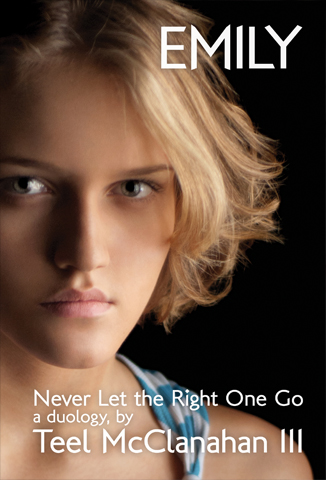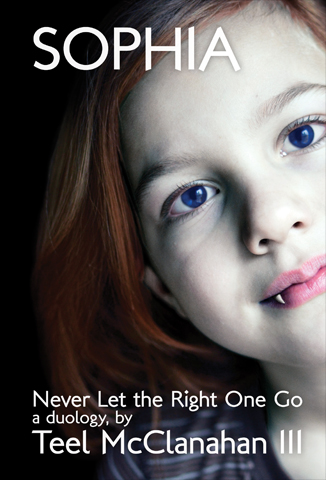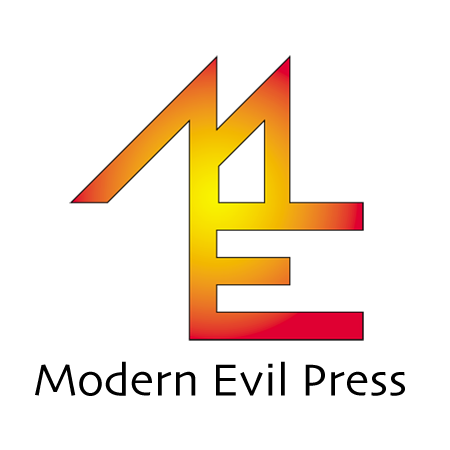by Teel McClanahan III, Copyright © 2012


Never Let the Right One Go is two novels in the same YA/vampire/paranormal/SciFi setting, but with apparently conflicting perspectives on that world as seen through the eyes of two very different teenage girls in their pursuit of love. (Which book should you read first?) It is available now from Modern Evil Press as two eBooks, as two audiobooks, and was available with both novels in a single signed, numbered limited edition (of 50) hardcover book.
SOLD OUT:
Hardback; 450pp, ISBN:978-1-934516-08-9; Limited edition of 50
Available as:
Sophia eBook; ISBN:978-1-934516-80-5
Emily eBook; ISBN:978-1-934516-81-2
Sophia Audiobook; 6hr 16mins
Emily Audiobook; 6hr 8mins
Sophia Podcast; 27 episodes (complete)
Emily Podcast; 26 episodes (complete)
Emily
Before she met Nicholas, Emily believed the vampires had her best interests in mind. Now she stands by his side in the fight for what’s right, while waging her own campaign in the fight for his heart. Emily follows Nicholas from the woods of Vermont to the White House and home again, putting her life and her blood on the line for a cause almost as important to her as the love she feels for him.
(Click for more info on Emily)
Sophia
Sophia’s conservative Christian parents have kept her isolated from the outside world for the last ten years. Is it any wonder she wants to move out the very night she turns 18, then falls in love with Joshua, the first young man she sees? Complicating Sophia’s quest for love are her body, frozen at age 7 when she was turned into a vampire, and her faith in God, making her passions feel like sins.
(Click for more info on Sophia.)
About the Limited Edition
The limited edition consisted of 50 copies (plus two proof copies I’ll be keeping for myself), each one signed and numbered twice – once per novel. A note on the numbering: Several methods for numbering the limited edition were considered. Something as simple as numbering each copy only once was possible, but seemed against the nature of the production and the idea of having both books being potentially equally first and complete. The next closest option was numbering both Sophia and Emily with the same number, followed by numbering all the copies of Emily in sequence with the copies of Sophia sequenced in the opposite order (ie: Sophia #1 = Emily #50, Sophia #2 = Emily #49, et cetera). A few other variations were possible, including ideas as unusual as using unique, non-numeral identifiers or numbering in a base other than base-10. In the end, I decided that each of the 100 novels (50 copies of Emily & 50 copies of Sophia) would be numbered by a roll of the dice, with repetition prevented by a simple tracking sheet. Instead of (2D10)/2, I decided I preferred the more unusual (1D6×1D8)+(1D3-1), with a coin flip to decide whether to add or subtract in the event of an already-used number coming up. If you wonder why, check the math. Here’s a video of me signing and numbering the limited edition:
If you wanted to own a particular number of the limited edition, you had twice as many opportunities (or, if you’re a true collector, maybe you needed two copies?) to get the number you wanted.
Now that all 50 copies are gone, they’re gone – I will never again publish a flipbook containing both novels of Never Let the Right One Go, and don’t expect to publish either individual novel as hardcover books. Since the series has not been wildly successful, unless there’s future overwhelming demand for it, I don’t expect to put together two paperback versions, one for Sophia and one for Emily … ever. Right now, I expect this 50-copy release will be the only physical edition of Never Let the Right One Go ever produced.
Which book should you read first?
Short answer: Read whichever you like first; I designed both Sophia and Emily to be introductory and primary.
Longer answer: Which book you read first will have a significant impact on how you see the world of Never Let the Right One Go, and how you see the characters, beliefs, and activities of whichever book you read second. Each book is designed to be a complete story, the story of one young woman as her eyes are opened to the world around her, and her life is changed as she steps out of her old comfort zones for the first time, but the paths taken and the end results are wildly different from one another. One of the books is told from the perspective of someone who sees the world as a dystopia, and is structured so as to demonstrate (as in a Euclidean proof) that the world is a dystopia, and the characters and plot are fashioned in the style of dystopian fiction both traditional and popular. The other book is told from the perspective of someone who sees the world as a utopia, and is structured so as to demonstrate that the world is utopian – or at least that everything which makes the world unique from our own has been an improvement both for the society and for the individual.
Based on the feedback of early readers who read both books I can also say that (probably) whichever book you read first you’ll like least, and whichever book you read last you’ll like most. After finishing one, they said they liked it, but after finishing both they preferred the other. Perhaps this is because people are convinced by whatever argument they’ve heard most recently, and each book is built as an argument for its own point of view; by reading the second argument, their perspective on the first is altered – usually reversed. Of course, there are other factors at play, as well. Maybe you can’t stand Nicholas, so reading Emily becomes difficult. Maybe you’re aggressively anti-religion, so Sophia’s Christian background and reliance on faith to get her through tough situations rubs you the wrong way. Maybe the long political and economic discourse in one is too dry, or the awkward and painful sexual situations in the other are outside your comfort zone. There are countless differences between the two books, any one of which may be the thing your opinion hinges upon.
None of these differences, however, puts one book ahead of the other. Both books cover roughly the same time period, the same few months of the same year. Both books introduce and explain the world in the course of the girls’ journeys, without repeating one another. The books are well-enough paralleled that going back and forth between them, one chapter at a time (as you would experience them by subscribing to the Modern Evil Podcast), is a reasonable and viable approach to Never Let the Right One Go, as a duology. (In fact, doing so will reveal even more about the differences and similarities between the girls and their lives – I recommend it for a re-read, rather than a first-read, as some of the story becomes even sweeter when you know what’s coming in both books.) Which book you read first is truly a matter of personal preference, or random chance, rather than any pre-determined order.
My personal preference: I prefer Sophia over Emily, personally. I think it’s the superior book, I think Sophia is the stronger character, and I think hers is the better story. I fundamentally disagree with the politics and basic beliefs of Emily, Nicholas, et al, and had a hard time writing them convincingly. I wrote Sophia (mostly) first, though a significant portion of the world-building I did only appears in Emily. I think starting with Sophia is the way to go, because I think it gives a better overall impression of the duology, though I also want to suggest that you start with Emily, since I want you to like Sophia better.
I know, I know, I’m no help. Sorry…
